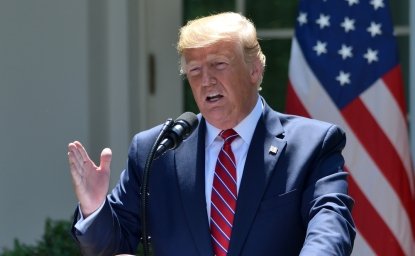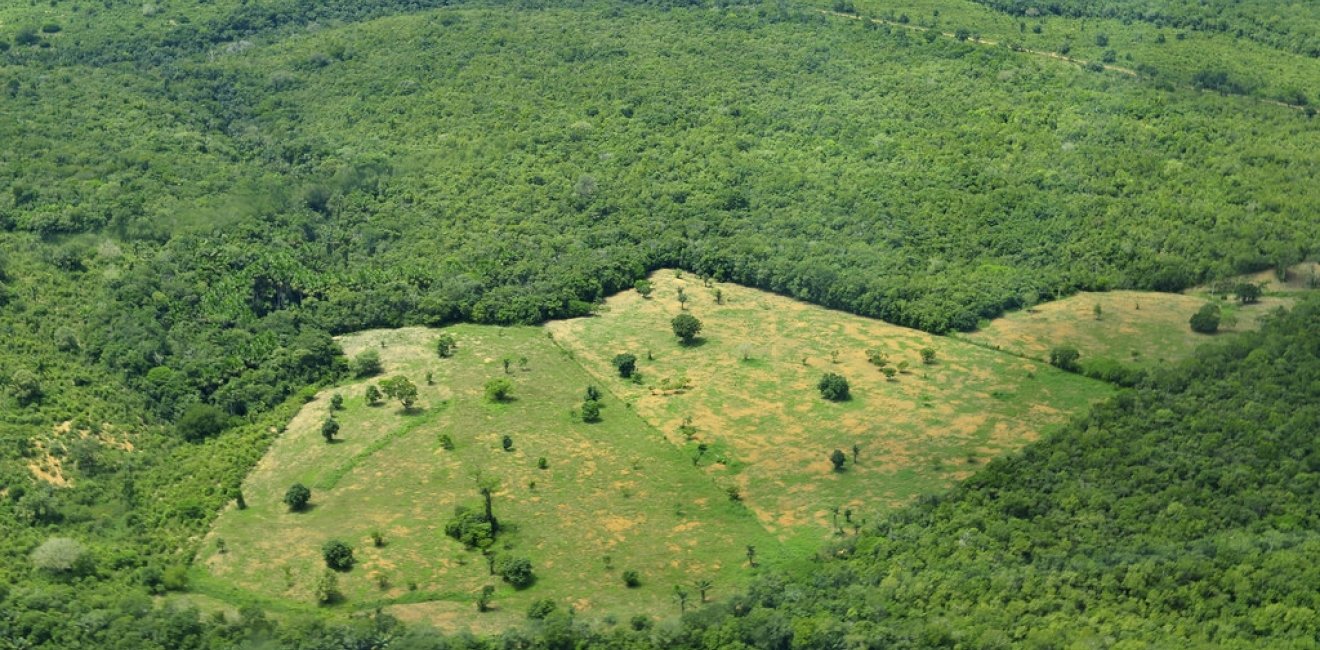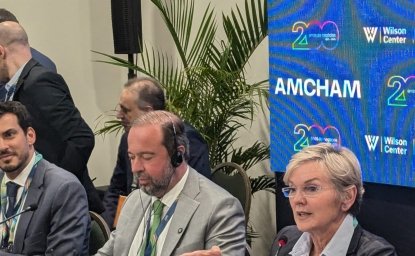
A blog of the Brazil Institute
Under internal and global scrutiny, the Bolsonaro administration in Brazil is facing strong pressure to reconsider its controversial environmental agenda. Although deforestation was a problem long before Jair Bolsonaro assumed power in January 2019, the future of the Amazon Rainforest is clearly threatened under the current government. A cover story article in The Economist on August 1 detailed the irreversible damage Bolsonaro’s proposals would inflict on the Amazon biome, and the resulting consequences for the future of Brazil and the world.
Deforestation rates have increased by 88 percent since December, yet the Bolsonaro government remains unconcerned. In fact, at a press conference on July 19, Environment Minister Ricardo Salles—along with President Bolsonaro, Foreign Affairs Minister Ernesto Araújo, and Institutional Security Office Minister General Augusto Heleno—questioned the validity of the satellite data on deforestation collected and presented by Brazil’s National Institute for Space Research (INPE).
However, such a stance is not without economic and diplomatic ramifications. Brazil’s Minister of Agriculture Tereza Cristina expressed concern that the government’s environmental policies might affect the country’s commercial prowess, particularly in the agricultural export sector. Ireland’s parliament and Italy’s farm minister have already called for blocking the Mercosur-European Union trade deal, and Germany decided to suspend $39 million in funds sent to Brazil to finance projects aimed at preserving the Amazon after reports that nearly 400 square miles of forests were cleared in July alone. Ignoring the negative effects of deforestation poses a threat to Brazil’s decades-long standing as a respected defender of the environment, benchmarked by the country’s participation in the 1992 United Nations Earth Summit in Rio de Janeiro and the landmark 2016 Paris Agreement. Brazil has been an indispensable player in global deliberations on climate policy, through actions to curb deforestation and widen protections of indigenous people.
Most troublingly, the government’s current policy demonstrates little awareness for the true importance of the Amazon—including its critical role in regulating the rainfall and weather patterns that have helped make Brazil an agricultural powerhouse. The country’s dependence on agricultural exports makes it highly vulnerable to climate change. Yet Brazil is uniquely poised to show the world that sustainable agriculture is possible, given its substantial expertise in agricultural research and innovation and its capacity to increase production without further deforestation. Combatting deforestation is not just in the interests of the world—it is in the economic and diplomatic interests of Brazil.
The world’s largest rainforest and one of Earth’s most vital natural resources, the Amazon is recognized as a carbon sink for its ability to absorb 25 percent of global CO₂ emissions. It spans 2.7 million square miles—nearly 1.5 times the size of the entire European Union—and is home to more than 10 percent of Earth’s living species. Though the Amazon Rainforest spans nine different countries, 64 percent of the biome falls within Brazil’s borders, in an area known as the Brazilian Legal Amazon. International climate change agreements in the past two decades have animated a collective moral and legal responsibility to protect such a biodiverse region, but much of the onus in enforcing these sweeping pledges falls on Brazil.
Deforestation in the Brazilian Legal Amazon had steadily increased from the 1970s through the end of the twentieth century, but the deforestation rate plummeted nearly 84 percent between 2004 and 2012. Much of this took place during the presidency of Luiz Inácio Lula da Silva (popularly known as Lula), who served from 2003 until 2011. Brazil viewed environmental policy as part of national strategic planning, and as a means for exercising Brazilian power and leadership on the international stage. Although it was not without critics, the plan sought to unite the bifurcating agendas of large-scale infrastructure and environmental protection, advocating for conservation-based policies that would stimulate development.
The Role of Environmental Policy Interventions
According to the United Nations Framework Convention on Climate Change (UNFCCC), reducing greenhouse gas emissions—and, by proxy, deforestation rates—is voluntary for developing countries. However, under pressure from civil society and international governments, the Lula administration signed into law a number of landmark policies that promoted environmental protections and sustainable agricultural practices.
Chief among them was the 2004 Action Plan for the Protection and Control of Deforestation in the Amazon (PPCDAM). This initiative encompassed a diverse array of policy interventions with three distinct purposes:
- To standardize land tenure rights and create new ecological reserves (over 190,000 square miles of reserves were designated between 2004 and 2011);
- To improve land-use monitoring practices through satellite imaging and digital surveillance; and
- To promote systems of sustainable agricultural production.
The PPCDAM set the precedent for future environmental conservation policies, though it included few mechanisms for enforcement or accountability. In 2007, a broad coalition of Brazilian and international non-governmental organizations launched the Zero Deforestation Pact, to pressure the federal government into developing policies to combat deforestation. The government responded in 2009 with the National Policy on Climate Change (PNMC), which set a national greenhouse gas reduction target of at least 36.1 percent by 2020, and required any mitigation actions to be “quantifiable and verifiable,” notes the World Resources Institute.
Many of Lula’s policy proposals could not have been implemented without the support of foreign governmental assistance and civil society organizations. In 2008, the Norwegian government pledged $1 billion to create the Amazon Fund; the money finances initiatives aimed at “preventing, monitoring, and combating deforestation, and promoting conservation and the sustainable use of the Amazon forest.” Additionally, Brazilian non-governmental and civil society organizations such as CONAFLOR, IMAZON, and FUNBIO are critical for monitoring and enforcing sustainable land use practices.
Local and Global Economic Conditions
In 1994, after years of efforts to rein increasing prices, the Brazilian government, under President Fernando Henrique Cardoso, initiated a new stabilization plan named after its new currency, the real, which was pegged to the U.S. dollar. Though successful in curbing inflation, the Real Plan faced enormous pressure following the financial crises in Asia in 1997 and Russia in 1998. Exchange rates began to deteriorate by 2002 with the economic downturn in Argentina and growing concerns that President Lula, elected that year, would default on the accumulated debt. Because of this, prices for domestic goods—primarily beef and soybean, two of Brazil’s largest exports—decreased, and many farmers responded by increasing their land-share to produce more in order to prevent their incomes from decreasing.
Yet as the economy began to expand again in the early years of the Lula administration, production did not return to its former levels: the soybean industry expanded further, with production rising from 15.8 million tons in 1990 to 67.5 million in 2010. Cattle-ranching saw similar expansions: beef exports increased seven-fold between 2000 and 2010, and Brazil is now the largest beef exporter in the world. Much of this growth was driven by increased demand for Brazilian exports by countries like China and the United States.
In many developing countries, as the economy expands, so does deforestation, as a result of increased production. However, even as industries expanded through the early 2000s, Lula-era policies successfully curbed deforestation by creating reserves, monitoring land-use, and promoting sustainable agricultural practices. The results were impressive: 3.5 percent average economic growth, and a 56 percent increase in national agricultural production coincided with an 83 percent decrease in deforestation from 2004 to 2012.
In addition to bold public policies, the market’s rejection of deforesting farmers played a significant role in decreasing deforestation. A 2006 Greenpeace report titled Eating Up the Amazon linked soybean production to “deforestation, global warming, water pollution, and even the use of slave labor,” implicating major companies like McDonald’s and grain exporter Cargill. In 2009, Brazilian NGOs released two additional reports—Time to Pay the Bill and Slaughtering the Amazon—which pointed at cattle ranchers, bankers, slaughterhouses, and beef exporters for the destruction of the Amazon. The international outcry that ensued forced multinational conglomerates and local ranchers alike to commit to more sustainable supply chain models.
Policy Changes Since 2012
However, this trend has not continued: deforestation rates increased by 73 percent between 2012 and 2018, though they have yet to reach the peak level measured in 2004. Much of this is spurred by the reversal of Lula-era policies: the conclusion of Lula’s term in 2011 opened the door for the bancada ruralista, the rural caucus in Brazil, which has gained significant political power in the past decade. Dilma Rousseff, who assumed the presidency after Lula, was more amenable to their rural infrastructure and development agenda in the Amazon, and today, the bancada ruralista currently control 40 percent of Congressional seats.
The first policy to enter the political crossfire after the conclusion of Lula’s presidency was the Forest Code. Originally passed in 1965, the Forest Code encompasses a series of presidential decrees—many of them enacted during the Lula administration—that regulates land use and management. In 2001, the Forest Code was modified to require landowners to conserve 80 percent of their property in the Amazon, and 20 percent in other biomes, known as Areas of Permanent Protection.
A key problem is that regulations in the original Forest Code proved difficult to implement, especially without proper systems to measure deforestation. Using the lack of enforcement as pretext, the bancada ruralista overhauled the Forest Code in 2012, with support from President Rousseff and the 160 politicians in Congress who represent agribusiness interests. The new law offers a series of startling changes, including:
- Granting amnesty to landowners who illegally deforested before 2008, which effectively reduces the area needing reforestation by 112,000 square miles, in order to meet global targets set under the PNMC;
- Decentralizing the management of Brazilian forests, delegating the mapping and registering of all rural properties to individual states (which requires additional legislation to implement); and
- Reducing the amount of forestry designated as Legal Reserves and Areas of Permanent Protection.
Though farmers and ruralist politicians argue that the new Forest Code stimulates economic development, environmental activists warn that the overhaul will incentivize deforestation by eliminating legal repercussions. However, the new Forest Code also “introduced new instruments that, once effectively implemented, allow for better monitoring of land use,” according to a recent report from the World Wildlife Fund. Among these instruments is the Rural Environmental Registry, which requires landowners to register property with the government. Sixty percent of all rural areas have already been recorded on the digital registry platform SICAR.
Beyond the relaxation of the Forest Code, the poor performance of the real in recent years has only worsened the rate of deforestation. In fact, from 2015 to 2016 alone, deforestation rates increased by 29 percent, the largest annual growth rate since Lula. This coincided with one of the worst recessions in Brazil’s history. As the real weakens, agricultural exports become more profitable, stimulating illegal logging and land-clearing deeper in the Amazon.
Furthermore, increased demand for agricultural production—especially soybeans and beef—stimulates investment in infrastructure, which often requires clearing nearby forests. The Rousseff administration, bolstered by the bancada ruralista, financed additional infrastructure projects under the new Growth Acceleration Program (PAC-2), primarily BR-319, a mega-highway from the northern city of Manaus to regions in the south, and the Interoceanic Highway, connecting southern Peru and the Brazilian ports of Rondônia and Acre. Rousseff also proposed building 30 hydroelectric dams in the Amazon as part of the country’s 2011-2020 energy-expansion plan. Though many of these dams remain under construction, they have caused enormous controversy: the Belo Monte Dam, completed in 2016 as the third-largest hydroelectric complex, displaced 40,000 indigenous people along the Xingu River. Richard Schiffman, environmental journalist with Reuters and The New York Times, notes the danger that “where roads are built in the Amazon, farmers and ranchers follow in droves to cut the forest.”
Under the new Bolsonaro administration, deforestation is expected to increase even further, with the recent approval of hundreds of new pesticides, the 95-percent cut to the Ministry of Environment’s budget for climate change-related activities, and the proposal to eliminate indigenous reservations in the Amazon, which represent 35 percent of the Amazon biome.
Most alarming is the lenient enforcement of environmental laws—from January to May of 2019, Ibama, Brazil’s Institute of the Environment and Renewable Natural Resources, imposed the lowest number of fines in the past decade. Government seizure of illegally-harvested timber has fallen from 883,000 cubic feet in 2018 to 1,410 in 2019, the equivalent of ten large trees. Even worse, deforesters rarely face punishment when caught—in fact, most are simply informed of the regulations violated. Without granting environmental agencies the power to monitor and prevent illegal logging, the Bolsonaro administration has further emboldened deforesters.
Recommendations for Curbing Deforestation
Without preventative, conservation-based legislation and renewed investment in innovative techniques for agricultural production, deforestation in the Amazon Rainforest—and in rainforests across Brazil—will continue to rise. Considering agricultural products account for nearly 30 percent of Brazil's export revenue, a combination of policies is required to promote sustainable agricultural development:
1. Implement incentive-based credit-lending policies tailored toward different environmental actors.
The demography of land tenure changed dramatically with the upheaval of the Forest Code. In 2011, smallholder properties (land under 100 hectares) accounted for 13.9 percent of total accumulated deforestation; large properties (under 500 hectares) contributed 47.7 percent; and very large landholders (under 2,500 hectares) 35.8 percent. However, recent data from the National Institute of Health has shown that the “deforestation share attributed to the largest properties (all land under 2,500 hectares) has declined by 63 percent, whereas that of smallholders increased by 69 percent.” Contrary to general belief, large agribusiness is decreasingly responsible for deforestation—and farmers on smaller properties are critical targets for conservation policies.
Reforming the credit-lending system is one way to directly influence smallholders, who rely most on access to rural credit. Analysts from INPUT (Iniciativa para o Uso da Terra) found that improved credit access for family farmers leads to higher agricultural productivity: family farmers rely on credit to invest in equipment and materials like seeds and fertilizer.
In 2008, the Brazilian Central Bank passed a resolution “mak[ing] credit for agriculture and ranching dependent on having no pending fines for illegal deforestation.” Though such fines are often not paid, a ban on credit takes immediate effect and cannot be appealed. This resolution most heavily impacted smallholders, who cannot easily afford to pay fines but depend the most on credit.
Thus, offering more favorable credit-lending conditions to smallholders who comply with—or go beyond—the requirements in the Forest Code would incentivize rural land registration and more sustainable smallholder farming. Because interest rates are higher on existing or already-cleared farmland, poorer farmers are unable to purchase arable land and must move deeper into the Amazon for unclaimed territory. Redefining farm size as a criteria of credit access, lowering interest rates for poor smallholders, and consolidating credit-lending conditions across regional banks will provide positive incentives to invest in new techniques for agricultural production. This also provides a stronger justification for government subsidies to support the banks offering credit to smallholder properties.
2. Reform Brazil's income and property tax codes to protect family farmers and promote sustainable agricultural production.
The current tax code in Brazil exacerbates inequality between smallholders and large corporations in ways that contribute to deforestation. Family farmers are often subject to higher income tax rates than agribusinesses, and tax deductions are offered primarily on investments unaffordable for small land-owners, such as farm vehicles, agricultural machinery, and breeder animals. The agriculture industry also provides important tax benefits for large holders and corporations, making agricultural projects attractive to investors. These policies encourage corporate demand for arable land, increasing prices. Poor smallholders, priced out of more expensive land holdings and looking to evade higher tax rates, often settle on inexpensive forested plots in the Amazon, as illustrated by the increase in deforestation share attributed to family famers since 2011.
The rural property tax regime also incentivizes deforestation. Based on the principle that land should be productive, it imposes higher tax rates on “unproductive” land, which includes forests. Land that is deforested—even without reason—is considered “used land,” and is therefore taxed less than preserved forestry. As in the case of other countries, the penalty for clearing forested land is often only a fine. However, these singular fines cost far less than the tax benefits and income generated from the land, which encourages large corporations and small family farmers alike to deforest their land.
A positive start would be to redefine “used land” to exclude deforested land and instead adopt terminology around land productivity. This not only encourages land preservation (especially in areas where biodiversity is high, such as the Amazon) but incentivizes reclaiming deforested areas. Additionally, developing a progressive, tiered corporate tax code that promotes sustainable family farming and closes depreciation loopholes for capital investments is central to curbing deforestation in the Amazon.
3. Invest in research and technology for sustainable agricultural practices, particularly those that use already-deforested land.
Numerous studies have already proven that Brazil can meet global food security demands without further destroying the Amazon Rainforest. Yet if farmers are to respond to these increasing agricultural demands in a sustainable way, they must have greater access to technology. One solution is investing in climate-smart agriculture: an integrative approach to farming that considers sustainable agricultural productivity, resilience against climate change, and a reduction in greenhouse gas emissions. Climate-smart agricultural programs were recently implemented in Brazil: the MAIS Program (Modulo Agroclimático Inteligente e Sustentável), which supports family agricultural production in the Jacuípe Basin, has already shown positive results. Additionally, data-enhanced remote sensing technologies properly administer water, fertilizer, and pesticides to increase productivity.
Further research can also be invested into more efficient deforestation monitoring systems. For decades, the National Institute for Space Research has used satellite data to record rates of deforestation across the Amazon. The DETER early-warning satellite system, launched in 2016, even sends law enforcement teams to illegally-deforested sites. However, the data is only released every three months. Developing a more effective and frequent monitoring process may help curb deforestation rates.
Brazil has made progress by investing in technology for sustainable production. But “despite the increase in agricultural productivity, the variation of productivity across farms remains huge, as a result of which more land needs to be brought under cultivation to compensate for poor yields,” according to a World Bank analysis.
4. Improve partnerships with the private sector to support agricultural innovation projects.
Much of the investment in technology comes from the private sector. Developing public-private partnerships to support the acceleration and implementation of sustainable production techniques will be critical for production in the Brazilian Legal Amazon, considering the lack of government revenue and enormous cuts to government-funded scientific research programs in recent months. Private sector finance and corporate commitments to sustainability play an enormous role in achieving forest conservation and restoration, according to a 2018 Forest Trends report.
Embrapa, the Brazilian Agricultural Research Corporation, has invested in developing the cerrado—Brazil’s largest savanna biome—into one of the country’s largest soybean production sites. The cerrado provides a cheaper and more sustainable alternative to the Amazon by increasing the area and productivity of existing farmland. This region now accounts for 50 percent of Embrapa’s grain production. Balbo, Brazil's largest producer of organic sugar, has invested in “ecosystem revitalizing agriculture,” a new approach to precision agriculture that revives ailing crops and land “starved of vitality” through decades of farming. Even McDonald’s, one of the biggest purchasers of Brazilian beef and soybean, has committed to taking steps to enforcing an environmentally-conscious supply chain; and Boeing recently announced a $1 million investment to support Brazil’s sustainable aviation biofuel industry.
The New Moral Imperative
There is an enormous environmental incentive to protect the Amazon Rainforest from deforestation: more tree cover is a natural barrier against the increasing rates of CO₂ emissions and global warming. However, there is also an economic incentive: a recent study found that the Amazon Rainforest, if kept intact, would preserve $8.2 billion of annual revenue in the economy. In fact, destroying the Amazon would “reduce rainfall so significantly that it would generate a $422 million annual loss to agriculture.” President Bolsonaro’s commitment to economic development would undercut the benefits the Amazon offers to Brazil’s economy, as well as to the rest of the world.
The Amazon Rainforest is a bulwark against global warming and a critical contributor to Brazil’s economic future. Innovative conservation-based policies, private sector investment, and international collaboration will all be vital to protecting one of Earth’s most valuable natural resources.
Image: Aerial view of the Amazon Rainforest, near Manaus, the capital of the Brazilian state of Amazonas, by Neil Palmer for CIAT, International Center for Tropical Agriculture [CC license]
Author


Brazil Institute
The Brazil Institute—the only country-specific policy institution focused on Brazil in Washington—aims to deepen understanding of Brazil’s complex landscape and strengthen relations between Brazilian and US institutions across all sectors. Read more

Explore More in Brazil Builds
Browse Brazil Builds
They're Still Here: Brazil's unfinished reckoning with military impunity



